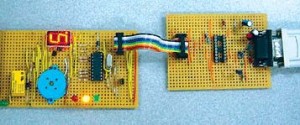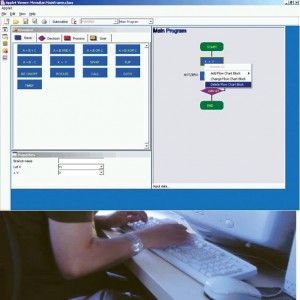Often time and support for implementing
an effective online e-learning system is underestimated. The environment and cultural background of students and instructors are often neglected and not understood. These results in many portals
reducing to a mere depository site where
students log on to download traditional
notes prepared by nstructors. This article
proposes a structure of the cooperative e-learning portal, based on an e-learning management system. The structure focuses on instructor and student centric active learning where students not only learn from their dedicated instructor but have the opportunity to share and learn from a pool of instructors and even students.
All researchers and content developers may be students and instructors at one point in time but not all content developers are instructors and students at the same time. Not many instructors are content developers, they may be content
providers also. This mismatch has hindered the widespread adoption of e-learning to the chagrin of the e-learning managers and implementers. As a result of this, many e-learning setups has been reduced to merely a depository portal – instructors uploading their existing Word, PDF or power point files for
students to download and thus has not released the real potentials of
 Problems of existing e-learning setups
Problems of existing e-learning setups
Many e-learning setups have been introduced in schools, tertiary institutions and organisations because of various reasons. Often the measurement of success in such adoptions are through the portal access volume statistics which is flawed, statistics does not reveal the satisfactions of the students and
instructors for such system nor it reveals much of the online learning experience. The environment and cultural background of students and instructors are often neglected and not understood. Supports and time for implementing an effective online e-learning system is often underestimated. Trainings, where provided to instructors, may not be effective because of time constraints and the steep learning curves of elearning development tools for non- IT personnel. All these results in many portals reduced to a mere depository site where students log on to download traditional notes prepared by instructors. Besides, third party content development is expensive and very often educational institutions are reluctant to spend or have very low budget for this. Requirements for performance and costs often contradict each other,
which may lead to user frustrations and disillusion for e-learning.
Cooperative e-learning portal
In this section, the proposed structure of the cooperative e-learning portal, based on the e-learning management system, ecLEMS (http://www. ecpresence. com), is presented along ith some illustrations on the logics and the benefits of such portal. Cooperative e-learning is about instructor and student centric active learning where students not only learn from their dedicated instructor but get the opportunity to share and learn from a pool of instructors and even students in a portal designed for sharing. The portal is organised under a broad umbrella of a learning centre where a group of schools or institutions conducting similar courses are signed up as partner members. All partner members can create courses on the portal for their own pupils organised in classes. Other members can join the course and share information created for the course by creating their own classes under the course. While information is shared in the background, students and instructors from members retain their own identity throughout the learning experience. In this way, instructors are not required to prepare every single content themselves but can focus on tackling what they do best – teaching and guiding the students. Content and materials come in various forms. The most important ones are the teaching materials. These can be in the form of simple power-point
slides, word documents or PDF files, flash or other interactive programmes, proprietary designed contents and even interactive simulators using Java Applets and others. These types of contents are expensive to write and develop and therefore it makes sense that it should be reached out to more users to share out the costs. Another area of learning materials is in the form of teasers,
quizzes and assignments. Instructor members can contribute to the pool by uploading them to the central bank under some defined common topics for the course that can be setup by instructor members themselves. With the aterials in lace, instructors and students can then benefit from these contents to embark on a more meaningful active learning with the built-in interactive tools. Interactivity depends very much on the cultural makes of individuals; some are more reserved while others are more ready to participate in group discussions. Hence, the portal caters to this diversity of student groups to bring them up gradually to the public discussion forum. Instructors can start by using the more private short message service (SMS) system to get the students to open up leading them to the public forum. Assignments and projects form one of the very important processes of learning. The portal provides an interactive feature for instructors to setup projects and assignment for students to submit. Instructors can then give feedback to individual students on their progress and make comments while the system will keep the parties involved and informed through emails. All these activities could be easily setup by the instructors and the students informed through the Announcement as shown in the image or the Planner system. Students could learn from their fellow classmates through the user pal system, ecLEMS Pals where students can seek out other users of the portal for discussion and friendship. In recent years, this form of interaction has generated a lot of interests by Internet users and this forms an important tool for online learning.
Students can form study groups to experience online interactive learning with other fellow users of the portal. The world-wide-web is more than a global network. It is a network of intelligent machines capable of not only fast computational activities but also a major resource of contents and content delivery. The proposed system taps onto these resources to create not just a standalone portal but a global integrated network of resources and servers to form a global e-learning portal. Partner members and individual users need not upload the contents onto the portal. They only need to register the contents to be used by students with the central portal server. The central server will keep track of the content information and the source computer server. Users will be channel to the appropriate resource to render out the content when requested through the portal. In this way, hardware resources as well as bandwidth
resource can be distributed over the global portal.
Case studies for interactivelearning using the proposed system
Two cases will be presented here to demonstrate the benefits of the proposed system. Case 1: The first involves the teaching of embedded or micro
controller system with hands-on Assignment project is then setup for students to carry the programming and loading onto the hardware. Throughout the project, students can submit the project progress report weekly through the project assignment page. Instructors can feedback and interact with the students by making comments on the project as it progresses. To mitigate instructors’ burden in tracking submission, emails are sent by the system to the instructors whenever students submit their reports. Similarly, students are
prompted when comments by instructors are submitted. Case 2: In this application, students were involved in an industrial attachment either locally or while in another country. Students are required to submit bi-weekly reports for the supervisors, one from the organisation where the student is attached to and the other from the institution, for record and assessment. The institution
supervisor or the instructor is often required to make appointment with the organisation supervisors and students for meetings. To ensure the students have a beneficial attachment, the instructor can feedback to the students through the portal based on the bi-weekly reports that he submitted. Every
single entry by the students and the supervisors are logged and can be easily retrieved and the parties involved informed through email whenever there is
a new update. In addition to the necessary close interaction between the instructor and the student in an online active learning environment, peers interaction is also necessary to set up the right cultural mode for a successful e-learning setup. The ecLEMS portal has demonstrated to have these features necessary to build upon a global e-learning portal.
 Interactivity depends very much on the cultural makes of individuals; some are more reserved while others are more ready to participate in group discussions. Hence, the portal caters to this diversity of student groups to bring them up gradually to the public discussion forum.
Interactivity depends very much on the cultural makes of individuals; some are more reserved while others are more ready to participate in group discussions. Hence, the portal caters to this diversity of student groups to bring them up gradually to the public discussion forum.
experience using an online Applet programmer, called PicWorks. A copy of the Applet view is shown above where users make use of a graphical tool to programme real-time system using ow-chart. Users make use of the interactive programme for the rogramming and debugging of the controller and subsequently uploading the binary programme onto the hardware for the final test. Students’ interests are upheld through the use of a web-cam to feedback to them the fruit of their ard work. At shown in the figure of the web-cam feedback image. First instructor can upload the content as power-point files, video such as the CoreChart and eRacer Project or talking head content for the formal teaching of micro controller.






















